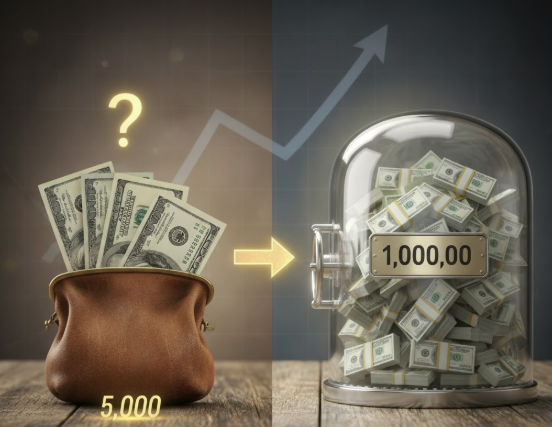Most investors have a fantasy in the back of their mind about taking $5,000 and somehow turning it into $1,000,000. It plays out like this: a late-night scroll through success stories online, Instagram reels showing traders flexing in Lamborghinis, and that one friend's cousin who "made it big." The logic works: the markets move, people get wealthy, so why not you?
The answer is much more complicated than that. Yes, it is likely possible to turn $5,000 into $1 million, but it's more than simply luck or an aggressive "go for it" strategy. It requires understanding what money actually grows, the best tools to use, withstanding the ridiculously small amount of risk, and, to be honest, whether your true risk tolerance can handle the ride.
The Power of Exponential Growth: Understanding Compounding
Compounding is easy to grasp but amazing in its effect—take an amount of money, that money earns return, the return earns return; repeat this long enough, and growth starts to feel like magic. Einstein referred to compounding as the eighth wonder of the world, which sounds correct.
Specifically, if you invested $5,000 and earned 10% a year, you end year one with $5,500. But in year two, 10% is now 10% of the 5,500, not the original 5,000. So you have gained $550 to arrive at $6,050. If I had a graph chart, you can start to see the increase getting exponential with time.
If we plug in a 10% return, after 35 years, your investment will be approximately $50,000. After 60 years, you will be at $1.3 million. Now if you could get a higher rate of return, say 25% per year, the time scales change pretty dramatically. With that return rate, you could get to $1 million in about 25 years. And hypothetically, if you could get a 50% rate of return, you could arrive at $1 million in about 15 years.
Leverage and High Returns: Accelerating Wealth Through Borrowed Power
Leverage is nothing more than borrowed money to boost your investment. You can use CFDs (Contracts for Difference), margin accounts, futures contracts, etc. The allure is easy to understand: you still have your $5,000, pay a broker to lend you $10,000 (for $15,000 total) and if your position goes up 10%, you've made $1,500 instead of $500! You've tripled your profit without tripling your capital requirements.
But lose, and you've also tripled your loss. That 10% gain is on borrowed money you need to repay. If the position goes down 10%, you've lost $1,500 of your $5,000 position. You're down 30%. If you get bad luck and the position goes down 20%, your entire $5,000 is gone and you still owe the broker their $10,000.
The Limits of Reality: Why $5,000 Rarely Becomes $1 Million Overnight
The first is volatility. Market movements are anything but smooth. The equity market can swing up and down on a daily basis. In 2020, the markets fell 30% in a matter of weeks. There is a good chance that your account, if started with $5,000, could fall to $3,500 in March, then recover by December. If you panic-sold when the market had bottomed, you would have captured that loss. Even if you held the account, the emotional decisions that come from watching your money evaporate can be powerful.
The second is fees and costs. Brokers charge commissions. Trading platforms charge spreads. If you are trading on margin or leverage, you have to pay interest on borrowed money. If you were trading on a short time frame, the costs add up and compound against you. A trader, for example, trading 50 trades a year, at $10 a trade, is wasting $500 each year on the commissions alone. A trader, after 20 years of trading a small amount of capital to start ($5,000) is looking at $10,000 in opportunity cost from the beginning from fees alone. That’s opportunity cost you can never get back.
Low-Risk vs. High-Risk Strategies: Finding Your Balance
If you have a conservative approach, you are affordably investing for slow and predictable growth over the timeline you defined. In this approach, you are comfortable buying index funds that track the broader market, holding those funds for years, and reinvesting dividends.
You may also buy some individual stocks, but you are diversified across sectors and geographies. You are realisitic and expect a return of 7-10 % annually on your investments and you sleep well each night! After holding $5000 in an S&P 500 index fund for 30 years, you can expect to hold between 50,000-100,000, depending on the performance of the market over that period. True wealth creation with little worry.
Take Action: Start Your Smart Investment Journey on Tradewill
There is such a gap between knowing what investing is and actually doing it. Most people know that they should invest early, compounding works, and then think "someday" to start because it feels too complicated.
If you want to build more wealth through index funds or invest in CFD trading with ways to managed-risks, there is something in the app you can use. The interface is clean, the spreads are competitive, and the customer support actually supports you in the development of your trading instead of moving transactions.
For more info:-






Comments